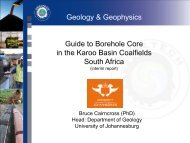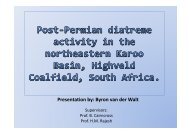coaltech upper olifants river catchment wetland inventory ...
coaltech upper olifants river catchment wetland inventory ...
coaltech upper olifants river catchment wetland inventory ...
Create successful ePaper yourself
Turn your PDF publications into a flip-book with our unique Google optimized e-Paper software.
3.5.2.4 Water quality<br />
Floodplain <strong>wetland</strong>s are connected systems with the water in different zones<br />
(compartments). These zones include the permanent, seasonal and temporary wet zones. It<br />
is therefore possible that salts previously deposited during a drying out cycle will be<br />
dissolved and leached from the soil during rewetting. This can contribute to a mineral<br />
exchange between floodwater and sediment. Flooding changes the redox potential in the<br />
<strong>wetland</strong> that will in turn increase the solubility of metals such as manganese and iron, and<br />
triggers the release of phosphates. The opposite applies when the <strong>wetland</strong> dries out. The<br />
concentration of nutrients in this <strong>wetland</strong> type is normally low, due to the dilution effect of<br />
water passing through the <strong>wetland</strong>. The wet and dry cycles in a <strong>wetland</strong>, therefore contribute<br />
to the water quality leaving the system. Water leaving the system during a drying out cycle<br />
will have less dissolved salts and will therefore be of a better quality (Palmer et al 2002,<br />
Kotze 2000, Kotze et al 2000).<br />
3.5.2.5 Storage and evaporation of mine water<br />
Wetlands can be used for the storage and evaporation of water, thereby contributing to<br />
potential storage facilities at mine sites. The use of natural <strong>wetland</strong>s in stead of man made<br />
dams is highly detrimental to the <strong>wetland</strong> (Palmer et al 2002, Kotze 2000, Kotze et al 2000,<br />
Limpitlaw 1995, 1996).<br />
3.5.3 Sediment trapping<br />
Wetlands play an important role in the sediment balance of streams and <strong>river</strong>s. Wetlands<br />
generally slow the water flow in a channel, thereby allowing the precipitation of sediments to<br />
take place. However, should the flow velocity increase, the sediment load in the water will<br />
increase as well (Palmer et al 2002, Kotze 2000, Kotze et al 2000, Kitheka 2003, Zierholtz<br />
2001).<br />
The soil losses in the portion of the UORC investigated by Palmer et al (2002) are moderate<br />
to high, at an average of 44 - 47 tons/km 2 /year. The extent to which <strong>wetland</strong>s contribute to<br />
sediment trapping in the <strong>catchment</strong> has not yet been determined. The presence of this<br />
function in <strong>wetland</strong>s depends on the type of <strong>wetland</strong> (Palmer et al 2002, Midgley et al 1994).<br />
Wetland Database for UORC - 38 -




